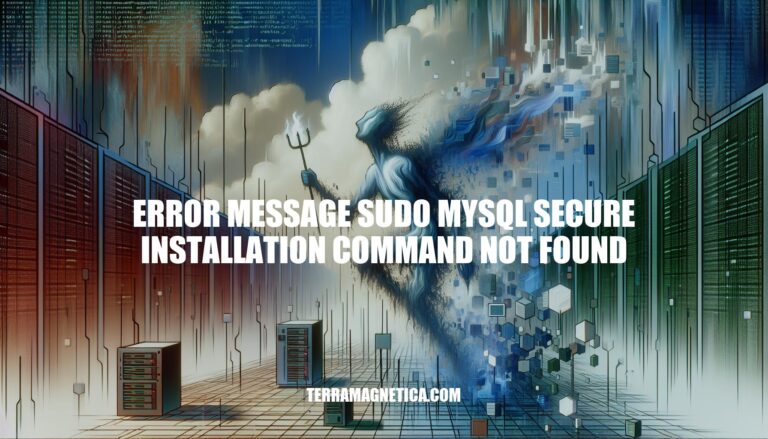


Are you encountering the frustrating error message ‘sudo: mysql_secure_installation: command not found’? Don’t worry, troubleshooting MySQL installation issues can be complex, but with the right guidance, you can resolve the issue and get back on track. Let’s delve into the steps to troubleshoot this specific error and ensure a smooth MySQL or MariaDB installation process.
The error message “sudo: mysql_secure_installation: command not found” occurs when the mysql_secure_installation command is not recognized by the system. Let’s troubleshoot this issue:
Check MariaDB Installation:
sudo apt update
sudo apt install mariadb-server
Verify MariaDB Service:
sudo systemctl start mariadb
Check PATH and Binary Location:
sudo /usr/local/mysql/bin/mysql_secure_installation
Replace /usr/local/mysql with the actual installation path if needed.
Update PATH Environment Variable:
.bashrc, .zshrc):
export PATH=$PATH:/usr/local/mysql/bin
Then reload your shell or run source ~/.bashrc.
Alternative Command for MariaDB:
mariadb-secure-installation
If you encounter the “sudo: mysql_secure_installation: command not found” error, here are some steps you can take to troubleshoot it:
Check MySQL Installation:
Ensure that MySQL (or MariaDB) is installed on your system. If it’s not installed, you’ll need to install it first. You can use package managers like apt, yum, or brew to install MySQL.
Verify PATH:
The error occurs because the mysql_secure_installation command is not found in your system’s PATH. You can either:
/usr/local/mysql, run:
sudo /usr/local/mysql/bin/mysql_secure_installation
.bashrc, .zshrc):
export PATH="/usr/local/mysql/bin:$PATH"
Then restart your terminal or source the profile to apply the changes.
Use mariadb-secure-installation (if applicable):
If you’re using MariaDB, try using mariadb-secure-installation instead of mysql_secure_installation. Some package managers now use this alternative name for MariaDB installations.
Permissions and User Authentication:
sudo).Let’s address this step by step:
Locating the mysql_secure_installation Script:
mysql_secure_installation script is typically located in the MySQL or MariaDB installation directory. You can find it by searching your system for the file name./usr/bin/mysql_secure_installation./usr/local/mysql/bin/mysql_secure_installation.find / -name mysql_secure_installation
Updating the PATH Variable:
mysql_secure_installation to your system’s PATH environment variable.~/.bashrc or ~/.bash_profile) using a text editor (e.g., nano, vim, or gedit).export PATH=/path/to/mysql/bin:$PATH
Reload the Shell Profile:
source ~/.bashrc
PATH variable.Verify:
mysql_secure_installation again. It should work without the “command not found” error.Remember to replace /path/to/mysql/bin with the actual path where mysql_secure_installation
Sudo (short for “superuser do”) plays a crucial role in Linux system administration. Let me explain why it’s so important:
Root User and Its Risks:
Enter Sudo:
Advantages of Sudo:
In summary, sudo has made Linux more secure and user-friendly by minimizing misuse of powerful root privileges and managing user access to admin tasks
Troubleshooting MySQL installation issues can be a bit tricky, but I’m here to help. Here are some tips to address common problems during MySQL installation:
Understanding the Problem:
Verifying MySQL Installation:
mysql --version
Reinstalling MySQL Server Package:
mysql-installer-web-community-5.7.22.1) and select “Update” when prompted.Checking MySQL Socket File:
Removing and Reinstalling MySQL:
ProgramData directory.Remember to consult the official MySQL Installation Guide for detailed instructions and additional troubleshooting tips. .
In conclusion, addressing the ‘sudo: mysql_secure_installation: command not found’ error requires a systematic approach. By verifying the MySQL installation, updating the PATH variable, and potentially using the alternative command for MariaDB installations, you can overcome this hurdle successfully. Remember to exercise caution, follow the steps meticulously, and consult reliable sources for additional support if needed.
With these troubleshooting techniques at your disposal, you can navigate through MySQL or MariaDB installation challenges with confidence and efficiency.